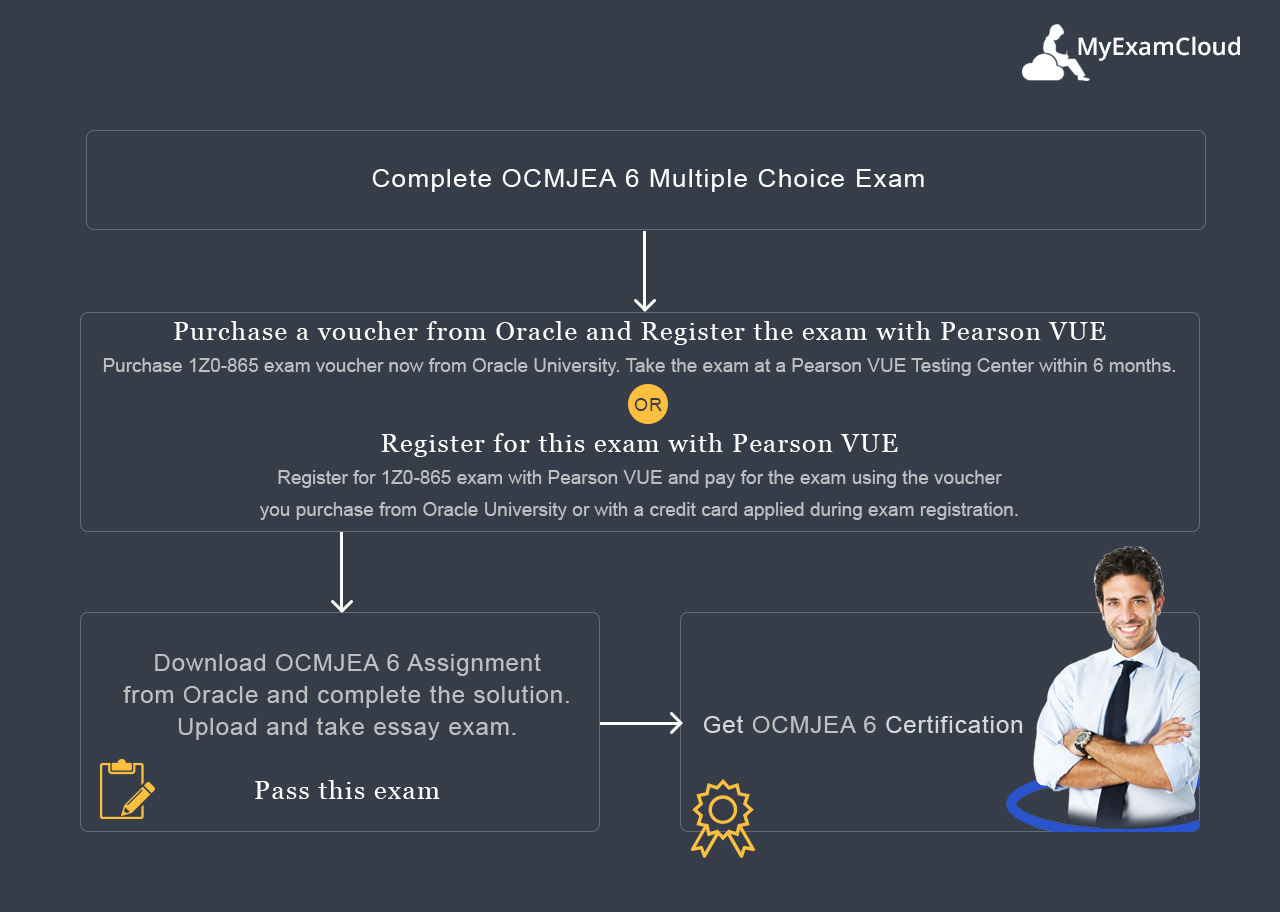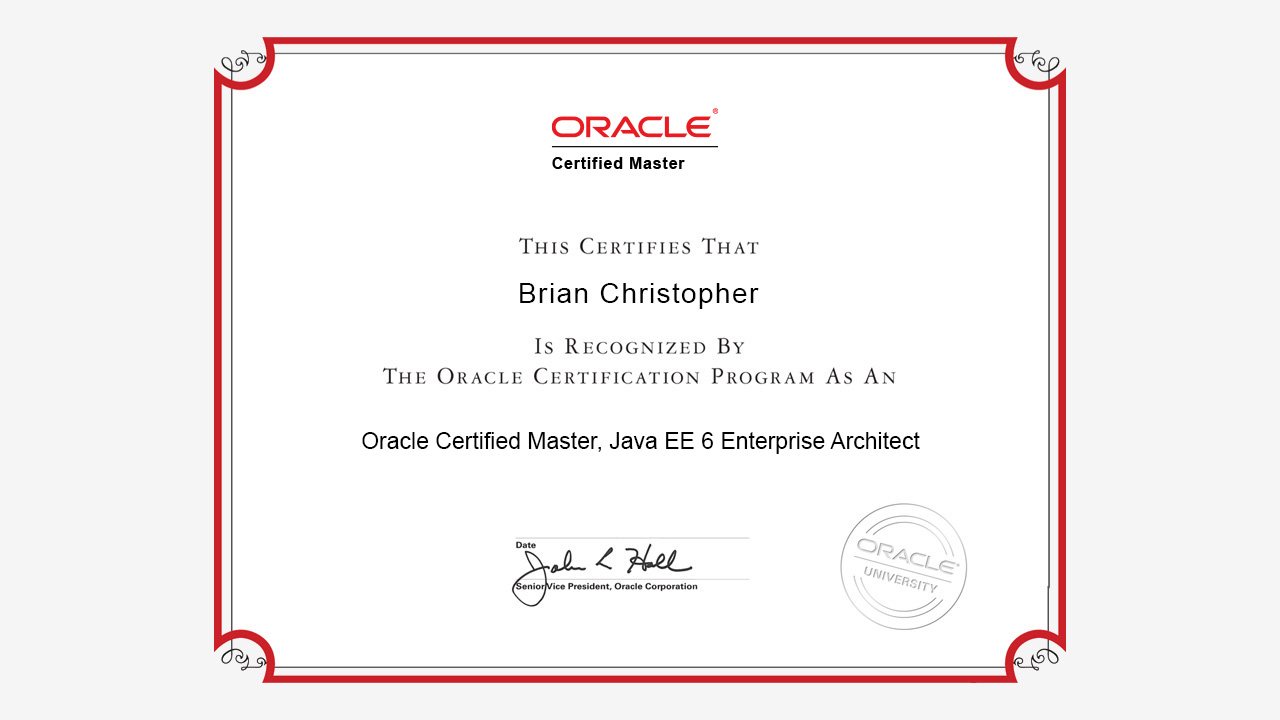10 OCMJEA 6 Assignment Practice Questions - Free
You can access 10 OCMJEA 6 Assignment Solution Quiz Practice Questions from MyExamCloud Exam Simulator.
Take Free Practice Testfor Oracle Certified Master Java EE 6 Enterprise Architect Certification
MyExamCloud OCMJEA 6 Assignment and Essay Questions simulator helps you to pass the exam in first attempt. Prepare with one of the best OCMJEA 6 Study Course developed by Java Certified Experts. 100% Test Pass Guarantee.
OCMJEA 6 Assignment and Essay documentations are available online at MyExamCloud Exam Simulator. This course contents can be accessed from PC, Mac, iPhone®, iPad®, Android™ Device. Mobile Apps available on iTunes and Android stores.
Inside MyExamCloud's OCMJEA 6 Assignment Practice Course
Set Goals on OCMJEA 6 Assignment topics
(MyExamCloud PPA Tracker)
OCMJEA Assignment Solution Quiz exam tests your basic architecture skills in each exam objective. (MyExamCloud Practice Exam)
MyExamCloud OCMJEA 6 assignments solution offers six assignment with complete UML design diagrams and documentation.
1 Quiz Exams
(MyExamCloud Quiz Exams)
MyExamCloud OCMJEA 6 Practice Test offers 128 review questions for the given six assignment solutions.
MyExamCloud OCMJEA 6 Practice Test also offers 128 review questions for the given six assignment solutions.
Study mode to access topic based questions
MyExamCloud OCMJEA 6 exam questions & answers, along with exhaustive explanations.
MyExamCloud reports to assess performance history, strengths & weaknesses against each topic
MyExamCloud goal tracker used to track your goals and shows how you accomplish your goals
MyExamCloud focus lab to pinpoint your weak areas, it will help you to complete your self-preparation
MyExamCloud platform gives you unlimited lifetime access, any where, any time and any device (Smart Phones / Tablets)
OCMJEA 6 simulator providing you with complete preparation materials for Java EE 6 Enterprise Architect Certified Master assignment and essay exams, along with review and quiz questions. Each and every architecture solutions are carefully evaluated by highly qualified Java architects. They are highly qualified individuals, who have 15 years of experience in Java EE technologies.
The OCMJEA 6 (Java (EE) Enterprise Architect Certified Master) Assignment improves architecture skills using patterns, frameworks and UML diagrams.

The OCMJEA 6 (Java (EE) Enterprise Architect Certified Master) Assignment improves architecture skills using patterns, frameworks and UML diagrams.
| Number of Questions: | N/A Questions |
|---|---|
| Exam Duration | 6 months from assignment purchase |
| Passing Score: | Subject to validation of assignment.% |
| Exam Format | Performance Based |
| Validated Against | This assignment has been validated against EE 5 and EE 6 |
| Exam Price | Price May vary from Country to country. Refer Oracle site for latest pricing. |
You must complete Java EE based architecture solution for a given business situation.
The OCMJEA 6 (Java (EE) Enterprise Architect Certified Master) Essay questions related to your assignment solution. Your answers to these questions will be accessible to the same analyst who evaluated your assignment submission, and he will cross-reference supplied answers with the submitted answer for assessing your answers.
| Number of Questions: | N/A Questions |
|---|---|
| Exam Duration | 120 minutes |
| Passing Score: | Subject to validation of assignment.% |
| Exam Format | Essay |
| Validated Against | This assignment has been validated against EE 5 and EE 6 |
| Exam Price | Price May vary from Country to country. Refer Oracle site for latest pricing. |
You must complete Java EE based architecture solution for a given business situation.
Set The New Java Standard With Java EE Architect Certification. The Java EE architect certification exam is a decent approach to distinguish your resume. Applicants who consistently guarantee they are up to speed on the most recent advances and hold significant certification in their picked technological advancements increase the value of their organizations. Any Java EE developer interested in architect career can take this exam.
The following practice question is taken from MyExamCloud OCMJEA 6 Assignment Solution Quiz
|
Scenario : Allinone's architect Pop suggests the following production environment.
The reason behind having separate servers is, when there is a change in one application it would not affect the other two and vice versa, so that we can maintain the application smoothly. Select the Non Functional Requirements dicussed in the above scenario - Read the scenario given below. Read the scenario given below. |
Answer and Explanation:Maintainability is the correct answerMaintainibility is ability to correct flaws in the exisiting functionality without affecting the other components of the system. When creating architecture, an architect should consider low coupling, modularity and documentation to enhance maintainabilty. |
You can access 10 OCMJEA 6 Assignment Solution Quiz Practice Questions from MyExamCloud Exam Simulator.
Take Free Practice TestWithin 30 minutes of completing your OCMJEA 6 Assignment Certification exam, you will receive an email from Oracle notifying you that your exam results are available in CertView. If you have previously authenticated your CertView account, simply login and select the option to "See My New Exam Result Now."
If you have not authenticated your CertView account yet at this point, you will need to proceed with your account authentication.
Authentication requires an Oracle Single Sign On username and password and the following information from your Pearson VUE profile: email address and Oracle Testing ID. You will be taken to CertView to log in once your account has been authenticated.

The reason for taking Oracle Java Certification is to differentiate general programmers from certified experts. You may get additional benefits like getting a good job, salary hike, designation changes, role changes and higher promotion.
Stand out from the millions of Java crowd. Increase your marketability with OCMJEA 6 Certification on the most used programming language in the world - Java.
The certification empowers in driving Java EE Architecture for enterprise applications. OCMJEA 6 certified architects can easily evaluate various design options, frameworks, software COTS components, etc.
Congrats, you have successfully scheduled your Java Certification exam.
|
Section 1: Application Design Concepts and Principles
Section 2: Common Architectures
Section 3: Integration and Messaging
Section 4: Business Tier Technologies
Section 5: Web Tier Technologies
Section 6: Applicability of Java EE Technology
Section 7: Patterns
Section 8: Security
Identify and classify potential threats to a system and describe how a given architecture will address the threats. |

I'm delighted to see that you guys providing assignment exam preparation solution for architect and developer exams. Excellent material !!!